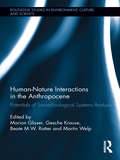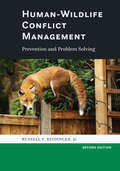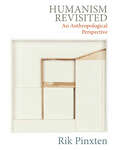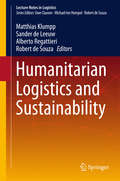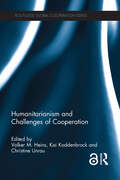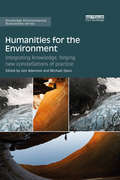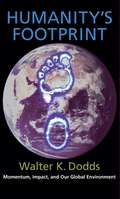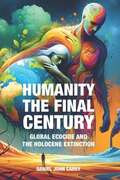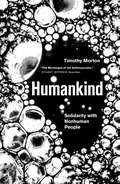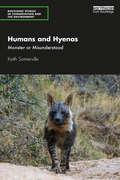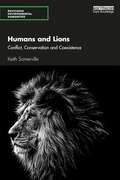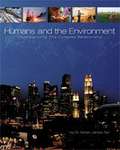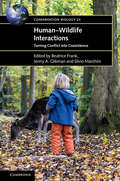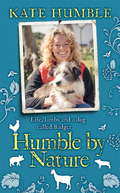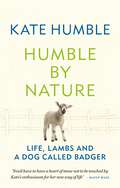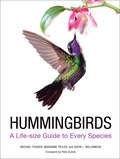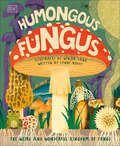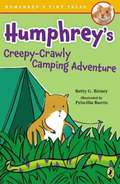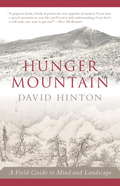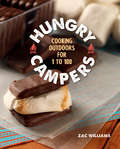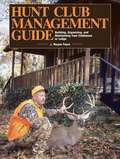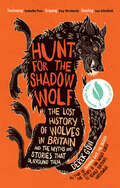- Table View
- List View
Human-Nature Interactions in the Anthropocene: Potentials of Social-Ecological Systems Analysis (Routledge Studies in Environment, Culture, and Society)
by Gesche Krause Beate M.W. Ratter Marion Glaser Martin Welp Andrew HallidayThis book deals with the potentials of social-ecological systems analysis for resolving sustainability problems. Contributors relate inter- and transdisciplinary perspectives to systemic dynamics, human behavior and the different dimensions and scales. With a problem-focused, sustainability-oriented approach to the analysis of human-nature relations, this text will be a useful resource for scholars of human and social ecology, geography, sociology, development studies, social anthropology and natural resources management.
Human-Wildlife Conflict Management: Prevention and Problem Solving
by Russell F. Reidinger Jr.The latest edition of this classic guide details how to understand and resolve a broad array of human-wildlife conflicts.This new edition of Human-Wildlife Conflict Management updates our understanding of the human dimensions, as well as biological and ecological concepts, underlying human-wildlife conflicts. While it provides wildlife professionals and students with the knowledge and adaptive management strategies to resolve such conflicts, it uniquely explores negative interactions with a wide range of wildlife taxa beyond those typically covered in traditional wildlife damage management, including invasive plants, invertebrates, and fish.Designed to help students and natural resource practitioners gain a deeper understanding of how to successfully avoid and resolve conflict between humans and wildlife, it is informed by author Russell F. Reidinger's decades of teaching students and professionals how to anticipate and manage human-wildlife conflicts, as well as his experience leading a national research program devoted to this work.The book covers important human-wildlife topics such as:• individual-, population-, and ecosystem-level effects• survey techniques• management methods• human dimensions• economic issues• legal and political aspects• damage management strategiesFeaturing explanations of important terminology and pertinent biological and ecological concepts, Reidinger also shares the latest research, provides a plethora of real-world examples, and includes suggestions for additional resources.
Humanism Revisited: An Anthropological Perspective
by Rik PinxtenThe West emancipated itself from the old humanism long ago and in doing so distanced itself from ‘heteronomy’: it declared that man, and not a non-human power, should be the first reference to approach people and nature. Today, as heirs of this tradition, we are still stuck in Eurocentrism (and often racism), and now even threaten to ruin nature by destroying biodiversity and causing the climate to warm up dangerously. Applied through an anthropological perspective, this book calls for a NEED-humanism: Not-Eurocentric, Ecological and (economically) Durable approach that can help promote inclusion and pluralism.
Humanitarian Logistics and Sustainability
by Matthias Klumpp Sander Leeuw Alberto Regattieri Robert SouzaThis contributed volume combines conceptual and strategic research articles dealing with the "why" and "to what end" of sustainable operations in humanitarian logistics, as well as operational research contributions regarding the "how" from the United Nations as well as from researchers and organizations from different countries (Germany, Australia, Singapore, Netherlands, Italy, Denmark, Jordan). The target audience primarily comprises research experts, decision makers and practitioners in the field, but the book may also be beneficial for graduate students.
Humanitarianism and Challenges of Cooperation (Routledge Global Cooperation Series)
by Volker M. Heins Kai Koddenbrock Christine UnrauHumanitarianism as a moral concept and an organized practice has become a major factor in world society. It channels an enormous amount of resources and serves as an argument for different kinds of interference into the "internal affairs" of countries and regions. At the same time, and for these very reasons, it is an ideal testing ground for successful and unsuccessful cooperation across borders. Humanitarianism and the Challenges of Cooperation examines the multiple humanitarianisms of today as a testing ground for new ways of global cooperation. General trends in the contemporary transformation of humanitarianism are studied and individual cases of how humanitarian actors cooperate with others on the ground are investigated. This book offers a highly innovative, empirically informed account of global humanitarianism from the point of view of cooperation research in which internationally renowned contributors analyse broad trends and present case studies based on meticulous fieldwork. This book will be of great interest to students and researchers in the areas of political science, international relations and humanitarianism. It is also a valuable resource for humanitarian aid workers.
Humanitarianism and Challenges of Cooperation (Routledge Global Cooperation Series)
by Volker M. Heins Kai Koddenbrock Christine UnrauHumanitarianism as a moral concept and an organized practice has become a major factor in world society. It channels an enormous amount of resources and serves as an argument for different kinds of interference into the "internal affairs" of countries and regions. At the same time, and for these very reasons, it is an ideal testing ground for successful and unsuccessful cooperation across borders.Humanitarianism and the Challenges of Cooperation examines the multiple humanitarianisms of today as a testing ground for new ways of global cooperation. General trends in the contemporary transformation of humanitarianism are studied and individual cases of how humanitarian actors cooperate with others on the ground are investigated. This book offers a highly innovative, empirically informed account of global humanitarianism from the point of view of cooperation research in which internationally renowned contributors analyse broad trends and present case studies based on meticulous fieldwork. This book will be of great interest to students and researchers in the areas of political science, international relations and humanitarianism. It is also a valuable resource for humanitarian aid workers.
Humanities for the Environment: Integrating knowledge, forging new constellations of practice (Routledge Environmental Humanities)
by Michael Davis Joni AdamsonHumanities for the Environment, or HfE, is an ambitious project that from 2013-2015 was funded by a generous grant from the Andrew W. Mellon Foundation. The project networked universities and researchers internationally through a system of 'observatories'. This book collects the work of contributors networked through the North American, Asia-Pacific, and Australia-Pacific observatories. Humanities for the Environment showcases how humanists are working to 'integrate knowledges' from diverse cultures and ontologies and pilot new 'constellations of practice' that are moving beyond traditional contemplative or reflective outcomes (the book, the essay) towards solutions to the greatest social and environmental challenges of our time. With the still controversial concept of the 'Anthropocene' as a starting point for a widening conversation, contributors range across geographies, ecosystems, climates and weather regimes; moving from icy, melting Arctic landscapes to the bleaching Australian Great Barrier Reef, and from an urban pedagogical 'laboratory' in Phoenix, Arizona to Vatican City in Rome. Chapters explore the ways in which humanists, in collaboration with communities and disciplines across academia, are responding to warming oceans, disappearing islands, collapsing fisheries, evaporating reservoirs of water, exploding bushfires, and spreading radioactive contamination. This interdisciplinary work will be of great interest to scholars in the humanities, social sciences, and sciences interested in interdisciplinary questions of environment and culture.
Humanity's Footprint: Momentum, Impact, and Our Global Environment
by Walter DoFor the first time in history, humans have exceeded the sustaining capacity of Earth's global ecosystems. Our expanding footprint has tremendous momentum, and the insidious explosion of human impact creates a shockwave that threatens ecosystems worldwide for decades-possibly centuries.Walter K. Dodds depicts in clear, nontechnical terms the root causes and global environmental effects of human behavior. He describes trends in population growth, resource use, and global environmental impacts of the past two centuries, such as greenhouse effects, ozone depletion, water pollution, and species extinctions and introductions. Dodds also addresses less familiar developments, such as the spread of antibiotic resistant genes in bacteria and the concentration of pesticides in the Arctic and other remote ecosystems. He identifies fundamental human activities that have irreversible effects on the environment and draws on recent social science and game theory results to explain why people use more than their share. Past behavior indicates that as resources grow scarce, humans will escalate their use of what remains instead of managing their consumption. Humanity's Footprint paints a lively but ultimately sobering picture of our environmental predicament. Dodds calls for a consilient approach to socioenvironmental restoration that draws on new thinking from across disciplines to develop sustainable solutions to global environmental problems.
Humanity: Global Ecocide and the Holocene Extinction
by Daniel John CareyIn October 2023, 16,000 scientists from 163 countries signed a warning to humanity that global climate change, ocean acidification, a collapse of human society, and the extinction of species are increasingly possible. This century. That is: If humanity as a whole doesn’t quickly get involved in working to restore wildlife habitat, protect Nature, and live more sustainably. If not, humanity faces: The complete collapse of society, including the end of the monetary, food, energy, water, sanitation, emergency, medical, transportation, communication, industrial, and government systems and services, the meltdown of hundreds of nuclear power plants, and the end of humanity. This century. Professor Lesley Hughes, board member of the Climate Change Authority, and an emeritus professor at Macquarie University recently said: “I don’t know how many warnings the world needs. It’s as if the human race has received a terminal medical diagnosis, and knows there is a cure, but has consciously decided not to save itself.” In his book "Humanity: The Final Century," Daniel John Carey uses quotations from scientists, studies, and reports from around the world mixed with his own commentary in a documentary style of writing to explain the state of Earth, Nature, wildlife, and humanity, and how all of it can soon end as we know it, and that this century might be the end of human history. Carey reasons that humanity needs an intervention for its addiction to destroying Nature and Earth. With this book, he encourages the conversations and actions needed for the solutions to take place.
Humankind: Solidarity with Non-Human People
by Timothy MortonA radical call for solidarity between humans and non-humansWhat is it that makes humans human? As science and technology challenge the boundaries between life and non-life, between organic and inorganic, this ancient question is more timely than ever. Acclaimed Object-Oriented philosopher Timothy Morton invites us to consider this philosophical issue as eminently political. It is in our relationship with non-humans that we decided the fate of our humanity. Becoming human, claims Morton, actually means creating a network of kindness and solidarity with non-human beings, in the name of a broader understanding of reality that both includes and overcomes the notion of species. Negotiating the politics of humanity is the first and crucial step to reclaim the upper scales of ecological coexistence, not to let Monsanto and cryogenically suspended billionaires to define them and own them.From the Trade Paperback edition.
Humans and Hyenas: Monster or Misunderstood (Routledge Studies in Conservation and the Environment)
by Keith SomervilleHumans and Hyenas examines the origins and development of the relationship between the two to present an accurate and realistic picture of the hyena and its interactions with people. The hyena is one of the most maligned, misrepresented and defamed mammals. It is still, despite decades of research-led knowledge, seen as a skulking, cowardly scavenger rather than a successful hunter with complex family and communal systems. Hyenas are portrayed as sex-shifting deviants, grave robbers and attackers of children in everything from African folk tales through Greek and Roman accounts of animal life, to Disney’s The Lion King depicting hyenas with a lack of respect and disgust, despite the reality of their behaviour and social structures. Combining the personal, in-depth mining of scientific papers about the three main species and historical accounts, Keith Somerville delves into our relationship with hyenas from the earliest records from millennia ago, through the accounts by colonisers, to contemporary coexistence, where hyenas and humans are forced into ever closer proximity due to shrinking habitats and loss of prey. Are hyenas fated to retain their bad image or can their amazing ability to adapt to humans more successfully than lions and other predators lead to a shift in perspective? This book will be of great interest to students and scholars in the environmental sciences, conservation biology, and wildlife and conservation issues.
Humans and Lions: Conflict, Conservation and Coexistence (Routledge Environmental Humanities)
by Keith SomervilleThis book places lion conservation and the relationship between people and lions both in historical context and in the context of the contemporary politics of conservation in Africa. The killing of Cecil the Lion in July 2015 brought such issues to the public’s attention. Were lions threatened in the wild and what was the best form of conservation? How best can lions be saved from extinction in the wild in Africa amid rural poverty, precarious livelihoods for local communities and an expanding human population? This book traces man’s relationship with lions through history, from hominids, to the Romans, through colonial occupation and independence, to the present day. It concludes with an examination of the current crisis of conservation and the conflict between Western animal welfare concepts and sustainable development, thrown into sharp focus by the killing of Cecil the lion. Through this historical account, Keith Somerville provides a coherent, evidence-based assessment of current human-lion relations, providing context to the present situation. This book will be of interest to students and scholars of environmental and African history, wildlife conservation, environmental management and political ecology, as well as the general reader.
Humans and the Environment: Understanding This Complex Relationship
by Adrian James TanThis introduction to sociology examines the complex relationship between humans and the environment and how this relationship changes over time, with technology as the catalyst.
Human–Wildlife Interactions: Turning Conflict into Coexistence (Conservation Biology #23)
by Beatrice Frank Jenny A. Glikman Silvio MarchiniHuman-wildlife conflict (HWC) is one of the most complex and urgent issues facing wildlife management and conservation today. Originally focused on the ecology and economics of wildlife damage, the study and mitigation of HWC has gradually expanded its scope to incorporate the human dimensions of the whole spectrum of human-wildlife relationships, from conflict to coexistence. Having the conflict-to-coexistence continuum as its leitmotiv, this book explores a variety of theories and methods currently used to address human-wildlife interactions, illustrated by case studies from around the world. It presents some key concepts in the field, such as values, emotions, social identity and tolerance, and a variety of insights and solutions to turn conflict into coexistence, from individual level to national scales, including conservation marketing, incremental and radical innovation, strategic planning, and socio-ecological systems. This volume will be of interest to a wide range of readers, including academics, researchers, students, practitioners and policy-makers.
Humble by Nature
by Kate HumbleIn 2007, after twenty years of living in London, Kate Humble and her husband Ludo decided it was time to leave city life behind them. Three years later, now the owner of a Welsh smallholding, Kate hears that a nearby farm is to be broken up and sold off. Another farm lost; another opportunity for a young farmless farmer gone. Desperate to stop the sale, Kate contacts the council with an alternative plan - to keep the farm working and to run a rural skills and animal husbandry school alongside it. Against all odds, she succeeds.Here, in Humble By Nature, Kate shares with us a highly personal account of her journey from London town house to Welsh farm. Along the way we meet Bertie and Lawrence the donkeys, Myfanwy and Blackberry the pigs and goats Biscuit and Honey, not forgetting a dog called Badger and his unladylike sidekick Bella. And we are introduced to the tenant farmers Tim and Sarah, the locals who helped and some who didn't, and a whole host of newborn lambs. Full of the warmth and passion for the natural world that makes Kate such a sought after presenter, Humble By Nature is the story of two people prepared to follow their hearts and save a small part of Britain's farming heritage, whatever the consequences.
Humble by Nature: Life, lambs and a dog called Badger
by Kate Humble'You'd have to have a heart of stone not to be touched by Kate's enthusiasm for her new way of life' - Daily MailIn 2007, after 20 years of living in London, Kate Humble and her husband Ludo decided it was time to leave city life behind them. Three years later, now the owner of a Welsh smallholding, Kate hears that a nearby farm is to be broken up and sold off. Another farm lost; another opportunity for a young farmless farmer gone. Desperate to stop the sale, Kate contacts the council with an alternative plan - to keep the farm working and to run a rural skills and animal husbandry school alongside it. Against all odds, she succeeds.Here, in Humble by Nature, Kate shares with us a highly personal account of her journey from London town house to Welsh farm. Along the way we meet Bertie and Lawrence the donkeys, Myfanwy and Blackberry the pigs and goats Biscuit and Honey, not forgetting a dog called Badger and his unladylike sidekick Bella. And we are introduced to the tenant farmers Tim and Sarah, the locals who helped and some who didn't, and a whole host of newborn lambs.Full of the warmth and passion for the natural world that makes Kate such a sought after presenter, Humble By Nature is the story of two people prepared to follow their hearts and save a small part of Britain's farming heritage, whatever the consequences.
Humble by Nature: Life, lambs and a dog called Badger (Kate Humble)
by Kate Humble'You'd have to have a heart of stone not to be touched by Kate's enthusiasm for her new way of life' - Daily MailIn 2007, after 20 years of living in London, Kate Humble and her husband Ludo decided it was time to leave city life behind them. Three years later, now the owner of a Welsh smallholding, Kate hears that a nearby farm is to be broken up and sold off. Another farm lost; another opportunity for a young farmless farmer gone. Desperate to stop the sale, Kate contacts the council with an alternative plan - to keep the farm working and to run a rural skills and animal husbandry school alongside it. Against all odds, she succeeds.Here, in Humble by Nature, Kate shares with us a highly personal account of her journey from London town house to Welsh farm. Along the way we meet Bertie and Lawrence the donkeys, Myfanwy and Blackberry the pigs and goats Biscuit and Honey, not forgetting a dog called Badger and his unladylike sidekick Bella. And we are introduced to the tenant farmers Tim and Sarah, the locals who helped and some who didn't, and a whole host of newborn lambs.Full of the warmth and passion for the natural world that makes Kate such a sought after presenter, Humble By Nature is the story of two people prepared to follow their hearts and save a small part of Britain's farming heritage, whatever the consequences.
Humble by Nature: Life, lambs and a dog called Badger (Kate Humble)
by Kate Humble'You'd have to have a heart of stone not to be touched by Kate's enthusiasm for her new way of life' - Daily MailIn 2007, after 20 years of living in London, Kate Humble and her husband Ludo decided it was time to leave city life behind them. Three years later, now the owner of a Welsh smallholding, Kate hears that a nearby farm is to be broken up and sold off. Another farm lost; another opportunity for a young farmless farmer gone. Desperate to stop the sale, Kate contacts the council with an alternative plan - to keep the farm working and to run a rural skills and animal husbandry school alongside it. Against all odds, she succeeds.Here, in Humble by Nature, Kate shares with us a highly personal account of her journey from London town house to Welsh farm. Along the way we meet Bertie and Lawrence the donkeys, Myfanwy and Blackberry the pigs and goats Biscuit and Honey, not forgetting a dog called Badger and his unladylike sidekick Bella. And we are introduced to the tenant farmers Tim and Sarah, the locals who helped and some who didn't, and a whole host of newborn lambs.Full of the warmth and passion for the natural world that makes Kate such a sought after presenter, Humble By Nature is the story of two people prepared to follow their hearts and save a small part of Britain's farming heritage, whatever the consequences.
Hummingbirds: A Life-size Guide to Every Species
by Marianne Taylor Sheri L. Williamson Michael Fogden“Packed with information . . . this book showcases species such as the Green-crowned Brilliant, the Fiery Topaz and . . . Cuban Bee Hummingbird.” —Daily MailHummingbirds have always held popular appeal, with their visual brilliance, extraordinary flight dexterity, jewel-like color, and remarkably small size.This is the first book to profile all 338 known species, from the Saw-billed Hermit to the Scintillant Hummingbird.Every bird is shown life-size in glorious full-color photographs.Every species profile includes a flight map and key statistics, as well as information about behavior, plumage, and habitat.This authoritative guide has been annotated by the world’s leading experts on hummingbirds and features a foreword by renowned birding author Pete Dunne.
Humongous Fungus (Underground and All Around)
by DKEmbark on a magical tour of the forest floor and discover one of the most fascinating living organisms on this planet - fungi!Not quite animals and not quite plants, the mysterious kingdom of fungi is full of secrets! Let&’s unearth them together with this weird and wonderful book about mushrooms. Inside the pages of this children&’s science and nature book, you&’ll discover exactly what fungi are and more! • Gorgeous illustrations in Wenjia Tang&’s popular style • Introduction to a scientific topic in an engaging, soft way, through scenes and thoughtful layouts • Everything kids would ever want to know on the overlooked but fascinating topic - fungi From tiny microbes to the largest living thing, fungi are everywhere! Without fungi, our ecosystem would not work. It provides food for plants and animals and creates a place for them to live. But beware, some types of fungi can destroy crops through fungal diseases or even change animals&’ behavior. This fascinating foraging book for kids is sure to keep little ones engaged and entertained! Did you know that fungi are made to make medicine for humans? Or that the most mushrooms can be seen in autumn? This picture book about nature is packed with fun facts about fungi. It includes gross-out stories of fungal infections that kids will love, incredible facts about "bananageddon", crop disease, epidemics, and zombified ants! It&’s the ultimate gift for children who are interested in nature and microorganisms.
Humphrey's Creepy-Crawly Camping Adventure
by Betty G. Birney Priscilla BurrisEveryone's favorite classroom pet is now starring in chapter books!Humphrey has had lots of adventures as the classroom pet of Room 26, but never one like this. He is going on a campout in the backyard with Heidi and her friends! There's stargazing, roasting marshmallows, searching for creepy-crawlies--and then there are the prank-loving boys next door, who want to prove that the girls are scaredy-cats. Humphrey doesn't think girls are scaredy-cats. He doesn't think girls are like cats at all. Can this VERY-VERY-VERY small hamster show them with a hairy-scary trick of his own? With sweet illustrations and an easy reading level, Humphrey's Tiny Tales are hamster-iffic for emerging readers.
Hunger Mountain: A Field Guide to Mind and Landscape
by David HintonLearning to see with the eyes of the ancient Chinese sages can change your view of the universe, as David Hinton demonstrates. He takes us on a series of walks up Hunger Mountain, a wilderness area near his home in Vermont. What he sees and describes about these outings is informed by the cosmos-view he's imbibed from his many years of translating Chinese poetry: a way of looking at nature, and our place in it, and a particular way of regarding the relationship between ourselves and the universe. It's a view that informs all the great Chinese poetry and art. It's found in Taoism and Chinese expressions of Buddhism, but it predates them by millennia, going back probably to the Paleolithic Age--and it's found in the structures of the Chinese language itself, and in the evolution of the system of writing. Each chapter takes its name and theme from a character of the Chinese alphabet, whose history and development Hinton examines. They originate as primitive marks, very literally expressing the simplest of ideas, from which they grow and develop through time to express concepts of great subtlety. The poets and artists understood this and kept their focus on the emptiness that gives birth to all things as they used language and images that sprang from that emptiness. We learn about this as David walks up and around Hunger Mountain, making observations about the landscape, his place in it, and the underlying geological reality, telling stories of the great poets as he goes. It's the profoundest kind of nature writing, and it's an exceptionally accessible entrée to an ancient Chinese view of the universe.
Hungry Campers: Cooking Outdoors for 1 to 100
by Zac WilliamsMouthwatering recipes for campfire cooking—perfect for scout groups, youth groups, families, and friends—by the author of Little Cowpokes Cookbook.Hungry Campers offers a handy selection of simple and easy to-make recipes that can be used by individuals and groups to prepare meals for all types of outdoor adventures. Simple recipes for breakfasts, lunches, dinners and desserts are complemented by menu plans for weeklong camps, multi-day backpacking trips and even overnighters, making it easy to get outdoors.Each chapter focuses on a specific type of camp cooking, including campfire cooking basics, large groups, Dutch oven, backpacking and recipes for aspiring wilderness gourmets. Helpful tips provide outdoor cooking wisdom for those just getting started as well as new ideas for experienced campers.Recipes for roughing it include: Stadium Brats, Sunnyside Sandwiches, Irish Breakfast, Stovetop Soda Bread, Peanut Butter Sandwich Bar, Beef Goulash, Cheese &‘n&’ Mac, Chicken and Dumplings, Firemen Enchiladas, Pioneer Pizza, Pumpkin Cobbler, Trout Florentine, Hiker&’s Cereal, Icebox Ice Cream, and more.
Hunt Club Management Guide: Building, Organizing, and Maintaining Your Clubhouse or Lodge
by J. Wayne FearsIf you ever wanted to create your own hunting club, this book is for you.In Hunt Club Management Guide, wildlife management consultant J. Wayne Fears teaches you how to take your dreams of owning and operating your own hunt club and make them reality. From locating the acres you'll build on to hanging your final set of antlers on the wall, Fears touches on everything you will need to start your own club.In addition to revealing the step-by-step process of organizing and building a great club, Fears also provides insight into maintaining a successful club that will last for decades. This insight includes tips to help:Generate a top-notch wildlife management programPlant and manage food plotsCreate effective rulesDraft contracts and agreementsDevelop quality deer management techniquesAttract deer to your landFrom club by-laws to game management plans, clubhouse to land acquisition, the Hunt Club Management Guide will be your manual for establishing an enjoyable and thriving hunt club.
Hunt for the Shadow Wolf [US Edition]: The lost history of wolves in Britain and the myths and stories that surround them
by Derek Gow"Terrific, life-lit moments come howling out of Hunt for the Shadow Wolf."—The Telegraph "[Derek Gow is] a wry, profane truth teller who is equal parts yeoman farmer, historical ecologist, and pirate."—Ben Goldfarb, author of Eager and Crossings "Beautifully crafted, fascinating and unbearably poignant, I totally loved this book."—Isabella Tree, author of Wilding Renowned rewilder Derek Gow has a dream: that one day we will see the return of the wolf to Britain as it has already returned elsewhere. As Derek worked to reintroduce the beaver, he began to hear stories of the wolf, both real and mythical, and his fascination with this creature grew. With increasing curiosity, Derek started to piece together fragments of information, stories and artefacts to reveal a shadowy creature that first walked proud through these lands and then was hunted to extinction as coexistence turned to fear, hatred – and domination. What Derek came to realize was that the underlying motives behind our hatred were actually far more prosaic and, like most persecutions, to do with power and profit. We turned the wolf into a savage beast and saw its extirpation as a civilizing mission. But the wolf survived far longer than many thought and Derek tells of his sightings of the wolf through folklore and mythology, the records of grand estates and parish churches as well as wolf heads, both real and recreated. With bitingly funny but also tender stories, Hunt for the Shadow Wolf is Derek’s quest to uncover the true nature of this creature because, as we seek to heal our landscape, we must reconcile our relationship with it. Before we can even begin to bring the wolf back, we need to understand it. "I have loved this chase dearly and though what unfolds might be an ending of sorts, I have no intention to let this hunt cease."―Derek Gow, from Hunt for the Shadow Wolf "Gow reinvents what it means to be a guardian of the countryside."—The Guardian
